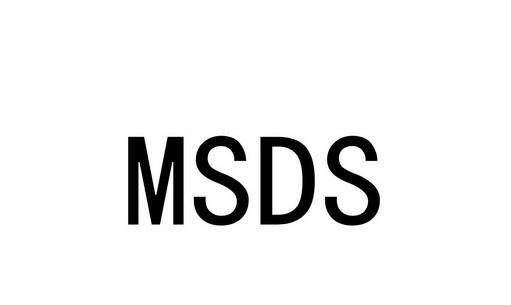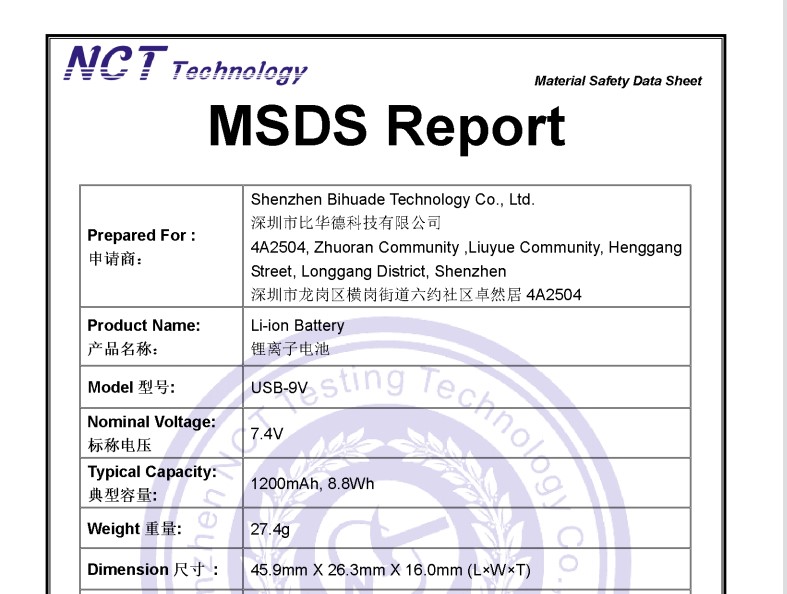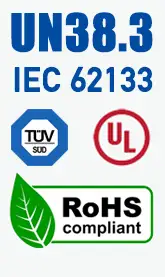LITHIUM POLYMER BATTERY
MSDS(MATERIAL SAFETY DATA SHEET)
Material Safety Data Sheet (MSDS) of LiPoly Battery is the battery manufacturer showing the chemistry characters. It’s a document that may pose a hazard to the user’s health such as carcinogenic, teratogenic, etc.

IDENTIFICATION OF THE SUBSTANCE/PREPARATION AND OF THE COMPANY/UNDERTAKING
Product Identifier
Product name: Lithium Polymer Battery
Model: LP452050
Other means of identification
Synonyms: none
Recommended use of the chemical and restrictions on use
Recommended Use: Used in portable electronic equipments; Uses advised against:
a)Do not dismantle, open or shred secondary cells or batteries.
b)Do not expose cells or batteries to heat or fire. Avoid storage in direct sunlight.
c)Do not short-circuit a cell or a battery. Do not store cells or batteries haphazardly in a box or drawer where they may short-circuit each other or be shore-circuited by other metal objects.
d)Do not remove a Lithium Polymer cell or battery from its original packaging until required for use.
e)Do not subject cells or batteries to mechanical shock.
f)In the event of a cdll leaking, do not allow the liquid to come in contact with the skin or eyes. If contact has been made, wash the affected area with copious amounts of water and seek medical advice.
g)Do not use any charge other than that specifically provided for use with the equipment.
h)Observe the plus(+) and minus(–)marks on the cell, battery and equipment and ensure correct use.
i)Do not use any cell or battery which is not designed for use with equipment.
j)Do not mix cells of different manufacture, capacity, size or type within a device.
k)Lithium Polymer Battery usage by children should be supervised.
I)Seek medical advice immediately if a cell or a battery has been swallowed.
m)Always purchase the battery recommend by the device manufacturer for the equipment.
n)Keep cells and batteries clean and dry.
o)Wipe the cell or battery terminals with a clean dry cloth if they become dirty.
p)Secondary cells and batteries need to be charged before use. Always use the correct charger and refer to the manufacturer’s instructions or equipment manual for proper charging instructions.
q)Do not leave a Lithium Ion Polymer battery on prolonged charge when not in use.
r)After extended periods of storage, it may be necessary to charge the discharge the cells or batteries several times to obtain maximum performance.
s)Retain the original product literature for future reference.
t)Use only the cell or battery in the application for which it was intended.
u)When possible, remove the Lithium Polymer battery from the equipment when not in use.
v)Dispose of properly.
2. HAZARDS IDENTIFICATION
Classification
No harm at the normal use. If contact the Electrolyte liquid in the Li ion polymer Battery, reference as follows:
Classification of the substance or mixture
Classification according to GHS
Acute Toxicity, Oral(Hazard category 4)
Acute Toxicity, Dermal(Hazard category 3)
Skin, irritate(Category 1B)
Eye Irritate(Hazard category 1)
Precautionary statements:
Prevention:
P263 Wash thoroughly after handling. P270 Do not eat, drink or smoke when using this product. P280 Wear protective gloves/protective clothing/eye protection/face protection.
Response:
P312: Call a Poison center or doctor/physician if you feel unwell. P302+P350-IF ON SKIN: Gently wash with plenty of soap and water P301+P330+P331-IF SWALLOWED: rise mouth. DO NOT induce vomiting. P305+P351+P338 IF IN EYES: Rinse cautiously with water for several minutes. Remove contact lenses, if present and easy to do. Continue rinsing.
3. COMPOSITION/INFORMATION ON INGREDIENTS
Chemical characterization: Mixtures
Description:
Product: Consisting of the following components.

4. FIRE-FIGHTING MEASURES
Suitable Extinguishing Media
CO2, dry chemical powder, water spray.
Specific Hazards Arising from the Chemical
Formation of toxic gases is possible during heating or in case of fire.
In case of fire, the following can be released:
Carbon monoxide(CO)
Carbon dioxide
Other irritating and toxic gases.
Hazardous Combustion Products
Carbon oxides.
Explosion Data
Sensitivity to Mechanical Impact No
Sensitivity to Static Discharge No
Protective Equipment and Precautions for Firefighters
As in any fire, wear self-contained breathing apparatus pressure-demand, MSHA/NIOSH(approved or equivalent)and full protective gear. For example: Wear self-contained respiratory protective device.
Wear suitable protective clothing and eye/face protection.
Special hazards arising from the substance or mixture:
Lithium Polymer Battery may burst and release hazards decomposition products when exposed to a fire situation.
Lithium polymer batteries contain flammable electrolyte that may vent, ignite and produce sparks when subjected to high temperature(>150°C), When damaged or abused(e.g. mechanical damage or electrical overcharging); may burn rapidly with flare-burning effect; may ignite other batteries in clothes proximity.
5. ACCIDENTAL RELEASE MEASURES
Personal precautions, protective equipment and emergency procedures
Personal Precautions Avoid contact with eyes.
Refer to section 8 for personal protective equipment. Ensure adequate ventilation. Remove all sources of ignition.
Evacuate personnel to safe areas.
Environmental precautions
Absorb with liquid-binding material(sand, diatomite, acid binders, universal binders, sawdust).
Methods and material for containment and cleaning up
Methods for containment Prevent further leakage or spillage if safe to do so.
Methods for cleaning up Use personal protective equipment. Dam up. Cover liquid spill with sand, earth or other Non combustible absorbent material. Pick up and transfer to properly labeled containers. Clean contaminated surface thoroughly.
6. FIRST-AID MEASURES
First aid measures
Eye Contact Rinse thoroughly with plenty of water, also under the eyelids. If symptoms persist, call a physician.
Skin Contact Remove contaminated clothing and shoes. Wash skin with soap and water. In the case of skin irritation or allergic reactions see a physician.
Inhalation Move to fresh air. If symptoms persist, call a physician.
Ingestion Do NOT induce vomiting. Drink plenty of water. If symptoms persist, call a physician.
Most important symptoms and effects, both acute and delayed
Swallowing Do not induce vomiting. Get medical attention.
7. HANDLING AND STORAGE
Precautions for safe handling
Handle in accordance with good industrial hygiene and safety practice. Avoid contact with skin, eyes and clothing. Wear personal protective equipment.
Was thoroughly after handling. Use this material with adequate ventilation.
The product is not explosive.
Conditions for safe storage, including and incompatibilities.
If the lithium ion polymer Battery is subject to storage for such a long term as more than 3 months, it is recommended to recharge the Lithium-ion Polymer Battery periodically.
3 months: -10°C~+40°C, 45 to 85%RH.
And recommended at 0°C~+35°C for long period storage.
The capacity recovery rate in the delivery state(50% capacity of fully charged)after storage is assumed to be 80% or more.
The voltage for a long time storage shall be 3.8V~4.8V range.
Do not storage Lithium-ion Battery haphazardly in a box or drawer where they may short-circuit each other or be short-circuited by other metal objects.
Keep out of reach of children.
Do not expose Lithium-ion Polymer Battery to heat or fire. Avoid storage in direct sunlight.
Do not store together with oxidizing and acidic materials.
Keep ignition sources away—Do not smoke.
Store in cool, dry and well-ventilated place.
8. EXPOSURE CONTROLS AND PERSONAL PROTECTION
Control parameters
Ingredients with limit values that require monitoring at the workplace: | |
12190-79-3 Lithium Cobalt Oxide | |
TLV(USA) | 0.02mg/m³ |
MAK(Germany) | 0.1mg/m³ |
Other Exposure Guidelines Vacated limits revoked by the Court of Appeals decision in AFL-CIO v. OSHA, 965 F.2d 962(11th Cir., 1992)
Appropriate engineering controls
Engineering Measures: Showers, Eyewash systems, Ventilation systems
Use adequate general or local exhaust ventilation to keep airborne concentrations below the permissible exposure limits Ensure adequate ventilation.
Individual protection measures, such ad personal protective equipment
Eye/Face Protection:
Protective gloves
Material of gloves:
The selection of the suitable gloves does not only depend on the material, but also on further marks of quality and varies from manufacturer to manufacturer. As the product is a preparation of several substances, the resistance of the glove material can not be calculated in advance and has therefore to be checked prior to the application.
Penetration time of glove material:
The exact break trough time has to be found out by the manufacturer of the protective gloves and has to be observed.
Respiration Protection
No protective equipment is needed under normal use conditions. If exposure limits are exceeded or irritation is experienced, ventilation and evacuation may be required.
Hygiene Measures
Handle in accordance with good industrial hygiene and safety practice.
9. PHYSICAL AND CHEMICAL PROPERTIES
Physical State | Form: Almost Cuboid |
Color: Sliver | |
Odor: Odorless | |
Odor Threshold: No information available | |
Change in condition | |
pH, with indication of the concentration | Not determined. |
Melting point/freezing point | Not determined. |
Initial boiling point and Boiling range | Not determined. |
Flash Point | Not determined. |
Evaporation rate | Not determined. |
Flammability (solid, gas) | Not determined. |
Upper/lower flammability or explosive limits | Not determined. |
Vapor Pressure | Not determined. |
Vapor Density | Not determined. |
Relative density | Not determined. |
Solubility in Water | Not determined. |
Solubility in other solvents | Not determined. |
n-octanol/water partition coefficient | Product is not self-igniting. |
Auto-ignition temperature | Not determined. |
Decomposition temperature | Not determined. |
Odor threshold | Not determined. |
Evaporation rate | Not determined. |
Viscosity | Not determined. |
other information | No further relevant information available. |
10. STABILITY AND REACTIVITY
Reactivity:
Stable under recommended storage and handling conditions.
Chemical stability:
Stable under normal conditions of use, storage and transport.
Thermal decomposition/conditions to be avoided:
No decomposition if used according to specifications.
Possibility of Hazardous Reactions:
None under normal processing.
Hazardous Polymerization:
Hazardous polymerization dose not occur.
Conditions to avoid:
Strong heating, fire, Incompatible materials.
Incompatible materials:
Strong oxidizing agents. Strong acids. Base metals.
Hazardous Decomposition Products:
Carbon oxides, other irritating and toxic gases.
11. TOXICOLOGICAL INFORMATION
Acute toxicity:
No data available.
Skin corrosion/irritation:
No irritant effect.
Serious eye damage/irritation:
Cause serious eye irritation
Respiratory or skin sensitization:
No sensitizing effects known.
Specific target organ system toxicity:
No information available.
CMR effects(carcinogenity, mutagencity and toxicity for reproduction):
No information available.
12. ECOLOGICAL INFORMATION
Toxicity:
No date available.
Skin corrosion/irritation:
No irritant effect.
Persistence and degradability:
No further relevant information available.
Bioaccumulative potential:
No further relevant information available.
Mobility in soil:
No further relevant information available.
Results of PBT and vPvB assessment
PBT: Not applicable
vPvB: Not applicable
13. DISPOSAL CONSIDERATIONS
Waste treatment methods
Recommendation: Must not be disposed together with household garbage.
Do not allow product to reach sewage system
Uncleaned packaging:
Recommendation: Disposal must be made according to official to official regulations.
14. TRANSPORT INFORMATION
The Lithium Polymer Battery had been tested according to the requirements of the UN manual of tests and Criteria.
The Lithium Polymer Battery with a Watt-hour rating not exceeding 100Wh or the cell with a Watt-hour rating in not exceeding of 20Wh.
The packaging shall be adequate to avoid mechanical damage during transport, handling and stacking. The materials and pack design shall be chosen so as to prevent the development of unintentional electrical conduction, corrosion of the terminals and ingress of moisture.
Meets requirements of International Maritime Dangerous Goods(IMDG)-2014 Special Provision 188 to be transported as non-dangerous goods;
Meets the requirements of 49CFR173.185 to be transported as non-dangerous goods for road, rail, air, and vessel.
Meets the requirements of TDG special provision 34 to be transported as non-dangerous goods.
The package must be handled with care and that a flammability hazard exists if the package is damaged;
15. REGULATORY INFORMATION
Safety, health and environmental regulations/legislation specific for the substance or mixture
EU Regulation:

